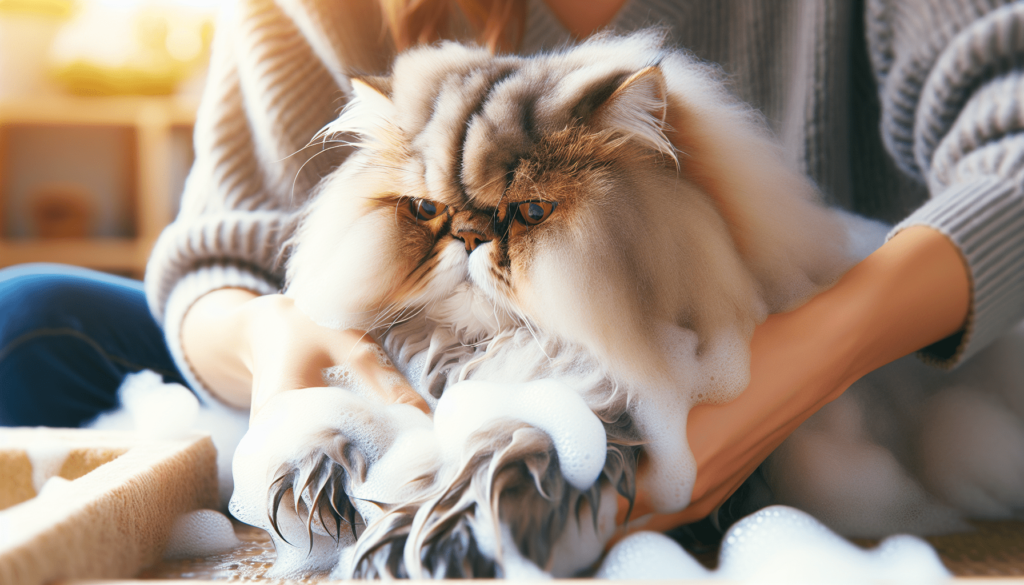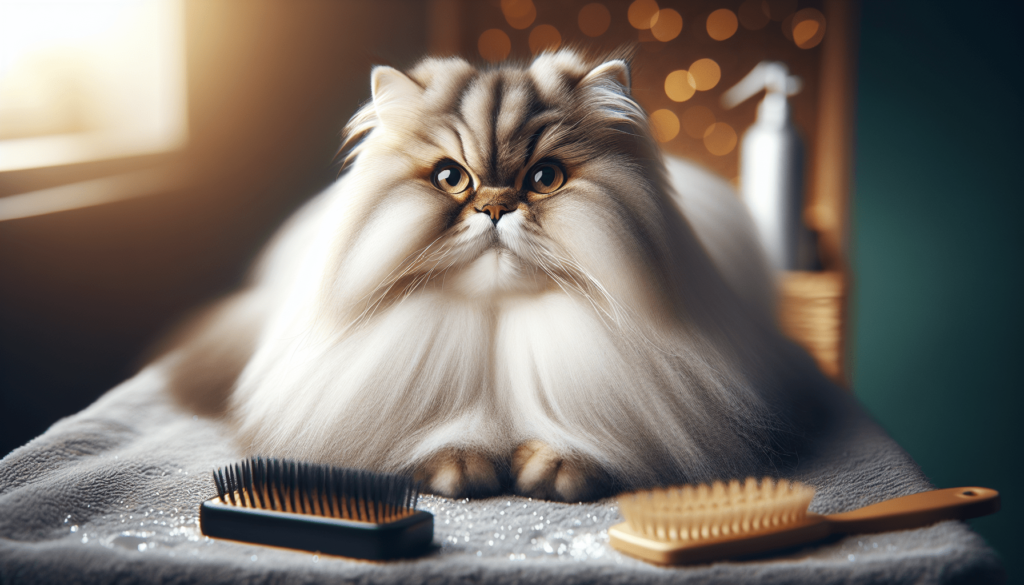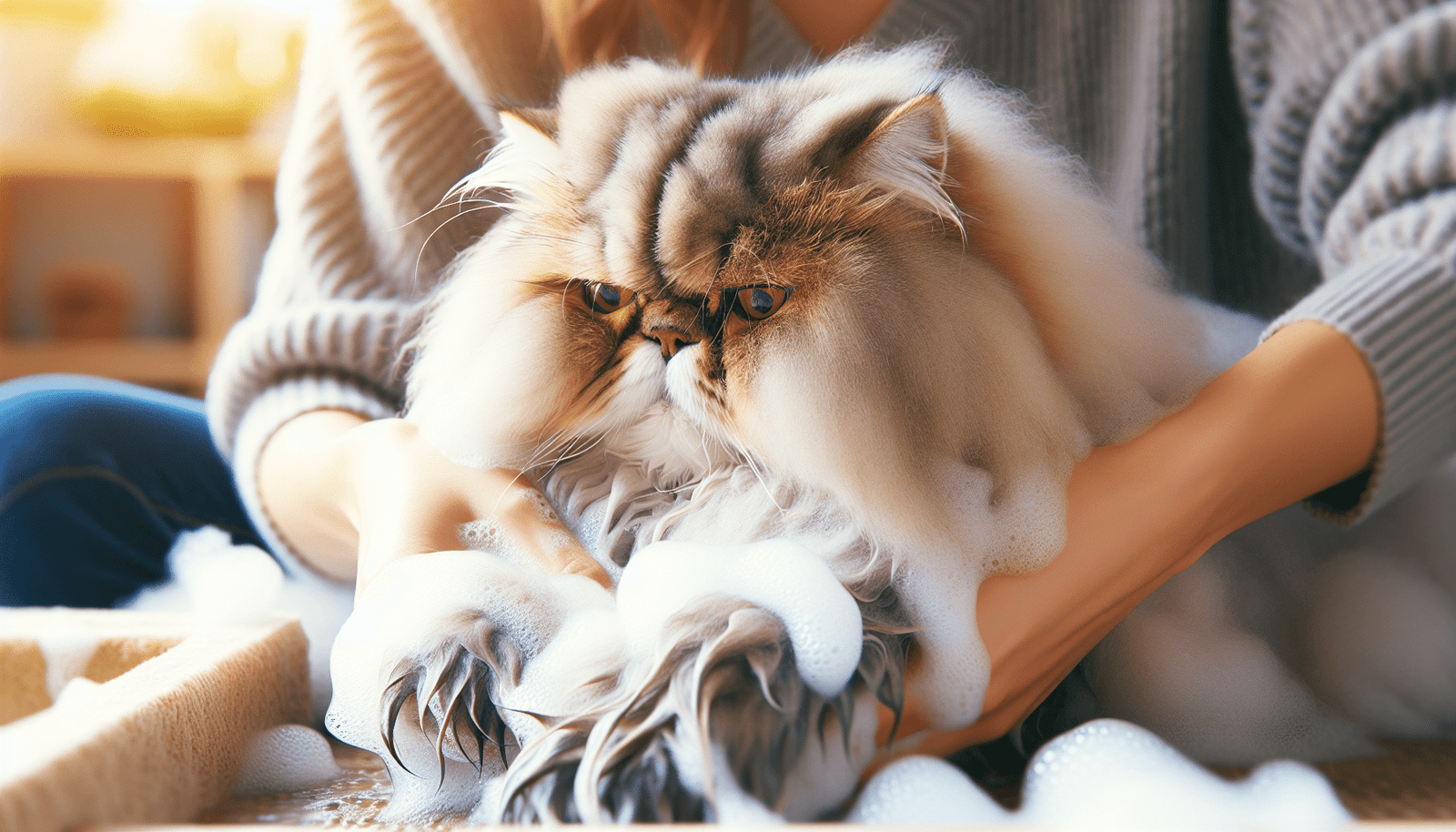If you’re the proud owner of a Persian cat and wondering whether you should bathe it despite diligently brushing its luxurious coat every day, you’re not alone. It’s a common question among Persian cat owners who want to ensure their furry friend’s hygiene and well-being. Knowing the answer can help you make informed decisions about maintaining your cat’s grooming routine.
Understanding Persian Cats
Persian cats are one of the most popular and beloved cat breeds worldwide. With their striking appearance and unique personalities, it’s no wonder they capture the hearts of cat lovers everywhere. To ensure the well-being of these magnificent felines, it is crucial to understand their physical characteristics and coat care needs.
Physical Characteristics of Persian Cats
Persian cats are known for their distinct features, including their round face, short muzzle, and large round eyes. They have a compact and sturdy body, with short legs and a fluffy tail. One of their most notable attributes is their luxurious and dense coat, which sets them apart from other breeds.
Coat Care Needs of Persian Cats
Due to the dense and long nature of their fur, Persian cats require regular grooming and maintenance to keep their coat in optimal condition. Grooming not only helps to prevent matting and tangling but also improves the overall health and appearance of their coat.
Persian Cat Grooming Basics
Grooming Persian cats involves two essential components: brushing and bathing. While brushing helps remove loose hair and prevents matting, bathing contributes to their overall hygiene by providing a more thorough cleaning of their coat. Let’s explore the importance of bathing in more detail.
The Importance of Bathing
Necessary for Overall Hygiene
Bathing is fundamental to maintaining the overall hygiene of your Persian cat. While regular brushing helps to remove loose hair and keep their coat looking neat, baths are necessary to deeply cleanse their fur and remove any dirt, debris, or oils that may have accumulated over time.
Prevents Skin Problems
Regular bathing can help prevent skin problems in Persian cats. Their dense coat can easily trap dirt, allergens, and irritants, leading to potential skin issues such as dryness, itchiness, or even infections. Bathing helps to cleanse the skin and remove these potential triggers, reducing the risk of skin problems.
Reduces Shedding
Bathing can also help to reduce shedding in Persian cats. By removing loose hair during the bath, you can effectively minimize the amount of loose fur that would otherwise be shed around your home. This not only keeps your living space cleaner but also reduces the occurrence of hairballs in your cat’s digestive system.
Promotes Healthier Coat
Regular bathing promotes a healthier coat for your Persian cat. It helps to remove any matting or tangles that may be present, allowing their coat to regain its natural luster and shine. Additionally, bathing can stimulate the production of natural oils in their skin, resulting in a soft, silky, and well-nourished coat.

Frequency of Bathing
General Guidelines
When it comes to how often you should bathe your Persian cat, general guidelines recommend bathing them every 4-6 weeks. This frequency allows for maintaining their coat’s cleanliness and overall health without excessively drying out their skin.
Consideration of Individual Needs
However, it is essential to consider the individual needs of your Persian cat. Factors such as their activity level, environment, and overall coat condition should be taken into account. If your cat spends a lot of time outdoors or has specific skin issues, more frequent baths may be necessary. Conversely, if your cat stays primarily indoors and has a healthy coat, less frequent baths may suffice.
Consulting a Veterinarian
If you’re unsure about the ideal frequency of bathing for your Persian cat, consulting with a veterinarian is highly recommended. They can assess your cat’s specific needs and provide tailored advice regarding grooming and bathing schedules. Additionally, they can recommend cat-safe products suitable for your cat’s skin and coat type.
Brushing vs. Bathing
Differences in Purpose
While brushing and bathing serve different purposes in grooming Persian cats, both are vital for maintaining their coat’s health and appearance. Brushing primarily focuses on removing loose hair, preventing matting, and distributing natural oils throughout the coat. Bathing, on the other hand, aims to thoroughly clean the fur, remove dirt, and promote overall hygiene.
Complementary Roles
Brushing and bathing play complementary roles in the grooming routine of Persian cats. Regular brushing helps to keep their coat tangle-free and minimize shedding, while bathing provides a deeper clean, addresses potential skin issues, and promotes a healthy coat. Combining both practices ensures comprehensive care for your beloved feline.
Effectiveness of Brushing Alone
While brushing is crucial for Persian cats, it is not sufficient for maintaining their coat’s cleanliness and overall hygiene. Brushing alone cannot remove dirt, oils, or allergens that may be trapped in their fur. Bathing is necessary to provide a more thorough cleansing, ensuring your cat’s coat is fresh, healthy, and free from potential irritants.
Brushing to Remove Loose Hair
Brushing your Persian cat daily is still essential, even if you give them regular baths. Brushing helps to remove loose hair before it has a chance to accumulate on their coat or be ingested, which can lead to hairballs. Additionally, daily brushing can help prevent tangles and matting, making bath time more manageable for both you and your cat.

Brushing Persian Cats
Recommended Tools
To effectively brush Persian cats, you’ll need the right tools. A stainless steel comb with wide and narrow teeth, a slicker brush or pin brush, and possibly a detangling spray can be helpful. These tools are designed to navigate through their thick fur, remove tangles, and gently massage the skin, enhancing blood circulation.
Establishing a Regular Brushing Routine
Establishing a regular brushing routine is essential for Persian cats. Daily brushing is recommended to prevent matting and tangling, particularly in cats with longer fur. Finding a quiet, comfortable spot where your cat feels relaxed and using gentle, slow strokes will help create a positive and enjoyable experience for both of you.
Techniques for Brushing the Coat
When brushing your Persian cat, start by using a comb with wide teeth to remove any tangles or matting gently. Then, switch to a slicker brush or pin brush to remove loose hair and distribute natural oils along the coat. It’s crucial to be patient, gentle, and avoid pulling on the hair to prevent discomfort or stress for your cat.
Challenges of Brushing
Tangles and Matting
Tangles and matting can pose challenges when brushing Persian cats, especially if their fur is not regularly maintained. These knots can be uncomfortable for your cat and may require detangling sprays or specialized grooming techniques to safely remove. Regular brushing helps to prevent tangles from forming in the first place, making the grooming process much easier and more enjoyable for your cat.
Potential Ineffectiveness for Deep Cleaning
While brushing is excellent for maintaining a well-groomed appearance, it has limitations when it comes to deep cleaning. Brushing alone cannot remove dirt, oils, or odor that may have accumulated on your cat’s coat. Bathing is necessary to thoroughly cleanse their fur and ensure their overall hygiene.
Limited Removal of Dirt and Odor
If your Persian cat spends a significant amount of time outdoors or is prone to getting dirty, regular brushing may not be sufficient to remove the dirt and odor from their coat. In such cases, bathing becomes essential to provide a comprehensive clean, keeping your cat fresh and free from potential skin issues.
Advantages of Bathing
Thorough Cleaning of Coat
One of the most significant advantages of bathing Persian cats is the thorough cleaning it provides. Bathing allows you to remove dirt, debris, and allergens that may have accumulated on their coat, helping to maintain their hygiene and prevent potential skin problems. A clean coat not only looks healthier but also feels softer and more pleasant to the touch.
Removal of Dirt and Odor
Bathing is essential for removing dirt and odor from your Persian cat’s coat. Their long and dense fur can easily trap dust, pollutants, and other unpleasant smells, which brushing alone cannot entirely eliminate. Giving your cat a bath helps to freshen their coat, leaving them smelling clean and revitalized.
Relief from Itching or Irritation
Bathing can provide relief from itching or irritation in Persian cats. If your cat has allergies or skin sensitivities, bathing with a gentle, hypoallergenic shampoo can help soothe any discomfort they may be experiencing. Proper bathing techniques and appropriate products can go a long way in alleviating itchiness and promoting a more comfortable coat.
Enhancing Bonding and Trust
Bathing your Persian cat can also strengthen the bond and trust between you and your feline companion. When done correctly and with care, bathing can become a positive and enjoyable experience for both of you. It allows you to interact closely, build trust, and create a deeper connection.
Bathing Persian Cats
Preparing the Bathing Area
Before bathing your Persian cat, it’s crucial to prepare the bathing area properly. Choose a warm and draft-free space, such as a bathroom or utility sink, where you can safely bathe your cat. Place a rubber mat or towel on the surface to provide traction and prevent slipping.
Gathering the Right Supplies
Gathering the right supplies is essential for a successful bathing experience. You will need a grooming brush or comb, cat-friendly shampoo and conditioner, a washcloth, and plenty of warm water. Additionally, have towels or a blow dryer on hand for drying your cat after the bath. Make sure to use products specifically formulated for cats to avoid any potential skin irritations.
Ensuring Safety and Comfort
To ensure the safety and comfort of your Persian cat during bathing, handle them gently and with confidence. Start by brushing their coat to remove any loose hair or tangles. Place cotton balls in their ears to prevent water from entering and causing discomfort. Maintain a calm and soothing tone throughout the process to keep your cat relaxed and at ease.
The Step-by-Step Bathing Process
The step-by-step process of bathing your Persian cat involves several stages. Begin by wetting their coat thoroughly with warm water, making sure to avoid getting water in their face and ears. Apply a small amount of cat-friendly shampoo and work it into a lather, gently massaging it all over their body. Rinse the shampoo completely, ensuring there is no residue left. If using conditioner, follow the same process, then rinse thoroughly again. After the bath, carefully dry your cat with towels or a gentle blow dryer on a low setting, taking care not to overheat them.
Considerations and Precautions
Choosing Cat-Safe Products
When bathing your Persian cat, always choose cat-safe products specifically formulated for feline use. Avoid using human or dog shampoos, as they can contain ingredients that may be harmful to cats. Look for gentle, hypoallergenic formulas that will effectively clean your cat’s coat without causing any irritations or dryness.
Avoiding Sensitivities and Allergies
Persian cats may have sensitivities or allergies to certain ingredients, so it’s essential to observe their reactions to the bathing products you use. If you notice any signs of discomfort, itching, or redness after bathing, discontinue the use of that particular product and consult with a veterinarian for alternative options.
Drying the Cat Properly
Properly drying your Persian cat after a bath is crucial to prevent them from catching a chill or developing skin issues. Use a soft towel to gently dry their coat, absorbing as much moisture as possible. If using a blow dryer, set it on the lowest heat setting and maintain a safe distance to avoid overheating their skin. Never use a high heat setting or direct the airflow onto their face or ears.
Preventing Water in the Ears
To prevent water from entering your Persian cat’s ears during bathing, place cotton balls gently into the ear canals. This provides a barrier and reduces the risk of water getting trapped, which can lead to irritation or infection. Remember to remove the cotton balls once the bath is complete.
Dealing with Resistant Cats
Some Persian cats may be naturally resistant to bathing or find the process stressful. If your cat exhibits signs of anxiety or resistance, it’s essential to approach bathing with patience and sensitivity. Gradually introduce them to the bathing routine, using positive reinforcement and rewarding them with treats or praise. If necessary, consult a professional groomer or veterinarian who can provide additional guidance and techniques to help make bathing a more comfortable experience for your cat.
Final Thoughts
Balancing brushing and bathing is key to the overall grooming and well-being of your Persian cat. While brushing helps to prevent matting and tangles, bathing provides a deeper cleanse and promotes overall hygiene. By observing your cat’s individual needs and consulting with a veterinarian when necessary, you can establish a grooming routine that suits their coat, skin, and overall behavior. Always prioritize their comfort, safety, and trust throughout the grooming process, ensuring a healthy and happy life for your beloved Persian cat.

